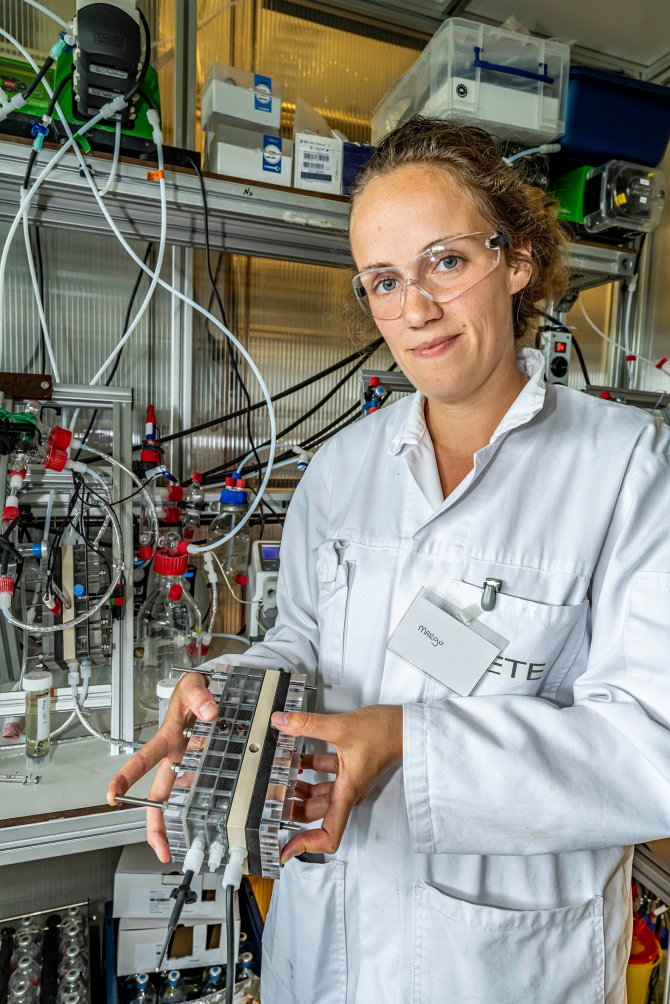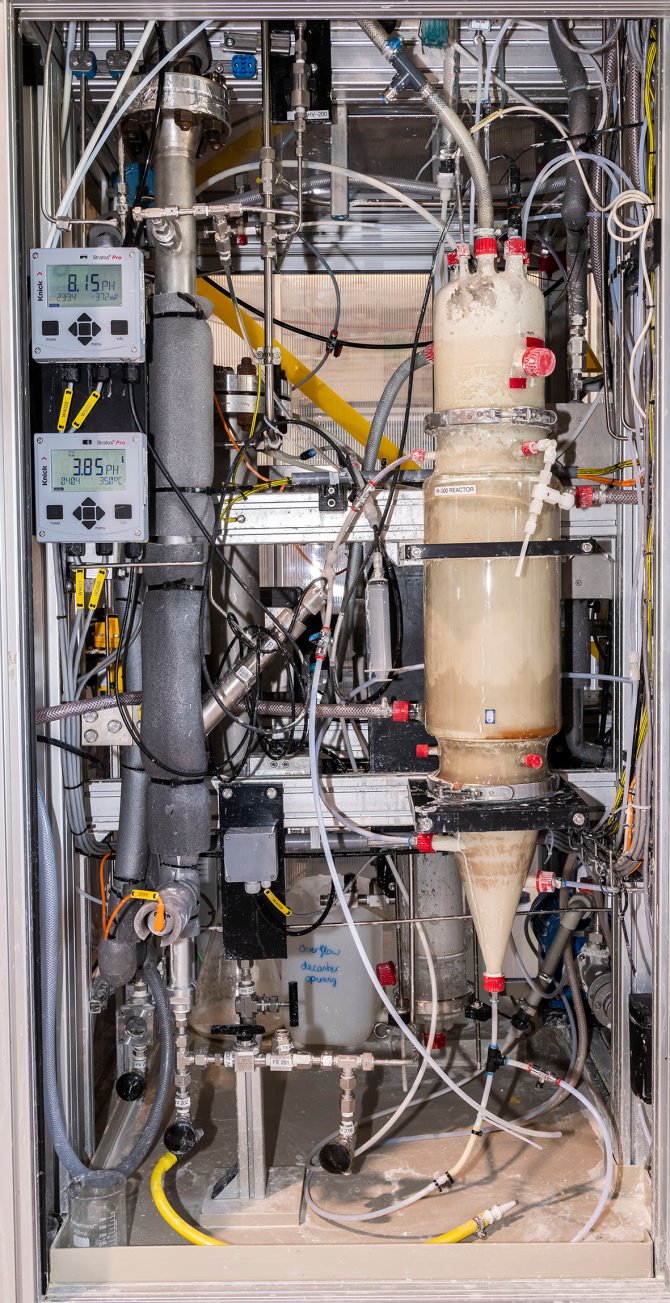
News
Science: Cleaning natural gas from toxic components using microorganisms and electricity
PhD scientists Margo Elzinga developed a safe and clean method to remove the highly toxic thiols from natural gas, using microorganisms and electricity. The proof of principle has been established and the next step is to further understand and scale the process.
Proudly Margo Elzinga holds a rectangular device consisting of several transparent,
plastic compartments that are stacked upon each other and secured with 10 long screws. It looks deceivingly simple and only measures about 15 times 7 centimeters. But the chemical reactions that happen inside are rather complex and of crucial importance to Elzinga’s research. ‘This is my baby’, she says jokingly. ‘In this bio-electrochemical system the magic happens: here, millions of microorganisms clean the toxic compounds present in natural gas.’ The device is divided into two main compartments, separated by a membrane. One compartment is stuffed with porous, black graphite cloth. This is the heart of the device and millions of microorganisms thrive here. Elzinga: ‘On this cloth, microorganisms, with the help of electricity, clean the toxic contaminants present.’

Polluting procedure
Natural gas contains, among others, the highly toxic so-called thiols or mercaptans, smelly compounds consisting of a carbon skeleton, with a sulfur (SH) group attached. These thiols are just one group of components present in natural gas that need to be removed. In addition, H2S is present, but in contrast to the thiols, there is an efficient method for H2S removal, and the recovery of pure sulfur, using the famous Thiopaq. This device is a large bioreactor, where microorganisms convert H2S into sulfur, following one of the established methods developed by Cees Buisman from ETE in the 1990’s. However, the thiols present are not only toxic, they also disturb the elimination of H2S, so removal is crucial. ‘Currently these thiols are either treated together with H2S, lowering the H2S
removal efficiency, or combusted in which case they’ll form sulfur dioxide’, Elzinga explains. ‘In the paper industry, there is also a thiol problem, that can be solved by bio-filtration, using a biofilter, where microorganisms convert the thiols into sulfate in the presence of oxygen.’ However, it is not the best idea to apply this method to natural gas due to explosion danger, while also the volumes to be cleaned in the natural gas are substantially larger. Elzinga therefore developed a new method, where a combination of microorganisms and electricity proved to be highly efficient in thiol removal from natural gas. Her ‘baby’ plays a crucial part in this thiol cleaning method. Inside the electrochemical system (Fig. 1), two electrodes are present with distinct functions. The anode first splits water into electrons (e-) hydrogen (H+) and hydroxyl (OH-) ions. The H+ formed moves through a cation exchange membrane, that only allows the passage positively charged ions, to the other electrode, the cathode. Here, microorganisms growing in the graphite cloth use this hydrogen, together with electrons also coming from the anode, and convert thiols into hydrogen sulfide (H2S) (Fig. 1). This compound can be further converted into pure sulfur in a next step inside the Thiopaq.

Horrendous smell
When Elzinga started the thiol removal project, there was little knowledge regarding this dangerous group of compounds. ‘Nobody knew how to work safely with these dangerous substances, which also has a horrendous sulfury smell’, she says. ‘I thought it was a really nice challenge, and everybody wanted to help finding a safe way to work with these compounds and remove these compounds from natural gas.’ Several years of research later, the new method shows great promise. Although Elzinga established the proof of principle, some challenges remain. For example, she is investigating if the method can be applied to a combination of thiols and not only to the individual ones, she has been testing so far.

Also, the stability of the process over longer periods of time is an important factor. Elzinga: ‘We have been running the reactor for over a year, and it seems to work fine, although we saw also the formation of other components, like the less toxic diethyl disulfide, thiosulfate and sulfate and we saw traces of elemental sulfur. In fact, this doesn’t matter really, it is great too, since also this compound can easily be converted into pure sulfur.’ The next step in Elzinga’s research is to scale the process and couple the set-up to the Thiopaq, so the system can work as one unit. A kind of a challenge, since the scientist doesn’t know for sure which side reactions will take place. For example, how diethyl disulfide will affect the conversion of H2S to elemental sulfur in the Thiopaq and vice versa.
It is also not clear how the intermediate products formed in the Thiopaq will affect the thiol removal system. After four years of research, Elzinga still is enthusiastic about her research on thiol removal. ‘It is a real pleasure to work with sulfur compounds, since there are so many different reactions possible, you can really go in all directions, and potentially discover other reactions’, she says. ‘We still don’t really understand in detail what reactions are taking place, but the experiments have clearly shown that our thiol removal method works.’
Selected publication:
Elzinga M., Dandan L., Klok J.B.M., Roman P., Buisman C.J.N., and Ter Heijne A. 2020. Microbial reduction of organosulfur compounds at cathodes in bioelectrochemical systems. Environ. Sci. and Ecotechn. 1, 10009. https://www.journals.elsevier.com/environmental-science-and-ecotechnology